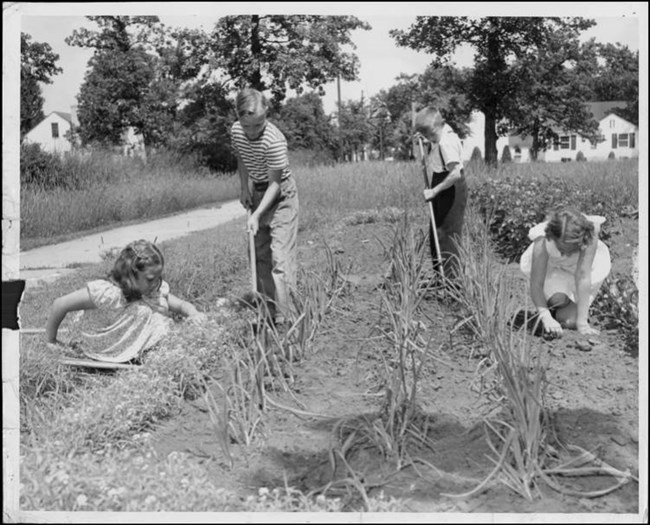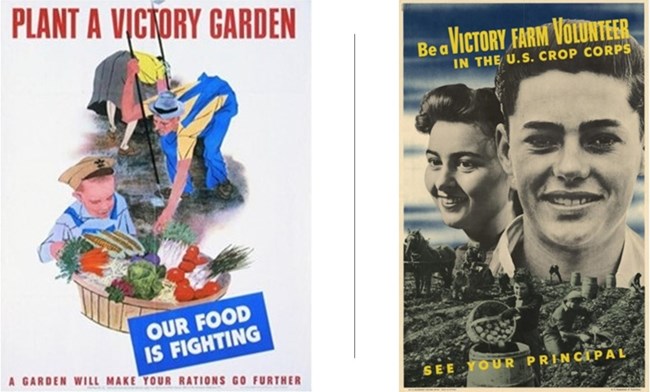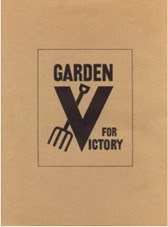Last updated: August 3, 2023
Article
(H)our History Lesson: The Dowling Victory Garden

Hennepin County Library
Introduction
This lesson introduces students to the history of the Dowling Victory Garden, the last remaining World War II victory garden in Minneapolis, Minnesota. It can be taught as part of a unit on WWII and the home front. Victory gardens are an example of government-led civilian home front efforts. This lesson supports learning the history of victory gardens and government education and propaganda. The lesson focuses on the role of children in victory gardening. The lesson has two readings and activity choices.
Grade Level Adapted For
Grades 6-12. Can be modified (ex. text support, selecting one text or activity) to suit upper elementary.
Lesson Objectives
Students will be able to...
- Explain the role and significance of victory gardens to home front mobilization efforts.
- Describe the importance of the Dowling School and its garden, and the current Dowling Community Garden.
- Examine and compare examples of government-produced victory garden education and propaganda materials (posters, videos to encourage engagement in the war effort).
Essential Question
How are the Dowling School Garden and the Dowling Victory Garden examples of home front mobilization efforts?
Background Readings
The primary and secondary source readings below will introduce students to the story of the Dowling School Garden and the Dowling Victory Garden.
Reading 1: Primary Source
From The Sunday Times, New Brunswick, NJ, Sunday April 18, 1943.
“Slightly blistered in many cases, but determined as you-know-what, the man with the hoe is busy everywhere throughout the land—planting a Victory garden to help solve the food problem.
Where there were thousands of home gardens in peace time, there will be hundreds of thousands this year, and already the advance of the garden battalions has resulted in regular runs on stores selling seeds, spades, spading forks, rakes, hoes, rolling cultivators and pressure sprayers—as well as supplies for preserving.
From Maine to California, from the Pacific Northwest to Florida, the soil of backyards and vacant lots is being turned to the sun, in many cases by folks who up to this year couldn’t tell a grub hoe from a trowel.
‘Every spadeful is a ration point!’ is the battle hymn of many, and even the people who were old hands at plotting pretty flower gardens are disdaining the sweet pea for spinach, the rhododendron for the radish, the tulip for the turnip. . . .”
-
What challenges to victory gardening did the writer refer to?
-
What changes, or sacrifices, did civilians make to participate in victory gardening?
-
How were victory gardens serving as a morale-boosting tool? Consider why civilian feelings of sacrifice may have been valuable for the war effort.
Reading 2: Secondary Source
Reading #2 is a secondary source summary of the history of the Dowling School Garden and Dowling Victory Garden.
Excerpt by Sarah Nestor Lane (January 2023)
Origin of the Dowling School
William Eustis was the former mayor of Minneapolis (1891-1893). He had saved money over his career to donate toward children with disabilities. Mr. Eustis had a disability and used crutches after contracting a severe disease as a teenager. He purchased 21 acres in May of 1923 and donated the land to the Board of Education of Minneapolis. The land must be “devoted exclusively to the physical, intellectual, and moral well-being of crippled children.” He also donated money for the construction of a new school on the site. This school was designed with accommodations for disabilities in mind.
The new Dowling School for Crippled Children was then built on the donated land. The school, established in 1920, moved to the donated property. The school's namesake was Michael Dowling, another prominent disabled Minnesotan.
The Dowling School Garden as a Victory Garden
During World War II, victory gardens were important to the home front efforts. The National Victory Garden program was one of the government responses to the attack on Pearl Harbor in 1941. It encouraged people to grow their own food in vacant lots or other spaces where they lived and worked. By 1943 approximately 21 million families had planted 7 million acres of victory gardens. This land produced about 42% of the total fresh US produce consumed that year.
In Minneapolis, Minnesota, there were local competitions and incentives to plant victory gardens. In 1943 a local Victory Garden Committee sponsored a Vegetable Fair. The committee reported 19,894 registered gardens that year. The Dowling School Garden was one of the gardens developed there. Rose and Elof Pearson led its creation in 1943 at the Dowling School site.
The Dowling School Garden’s land had been a marsh, and developers had filled it with rocks and clay. This hurt the land’s ability for cultivation. The Dowling School still took on the land's development. In 1945-1946 the school reported the maintenance of a 30 x 40 ft garden plot. This garden plot was separate from, and in addition to, the Dowling Victory Garden. There were 130 student participants, who planted produce like potatoes, carrots, and tomatoes. The paths in the garden facilitated access by students in wheelchairs. The “Garden Project” supplemented school lunches. School officials used it to encourage students to start victory gardens at home.
Today’s Dowling Victory Garden
The Dowling School Garden fell out of use. Gardening was no longer listed as an activity at the school by the 1950s. But in the nearby community Dowling Victory Garden survived and continued to change and develop over time. The gardeners overcame plans for the land’s development and the Dowling Garden is still functioning today as a community garden. It has its own Garden Committee and website (http://www.dowlingcommunitygarden.org/). It is one of the last in-use Victory gardens today, and the only one remaining in Minneapolis. The garden is a reminder of the other Victory gardens that once populated the area, such as the Dowling School’s Victory Garden.
-
Why did Eustis donate land to the Board of Education of Minneapolis?
-
What was the role, and importance, of local victory gardens?
-
How do you think the Dowling School’s Victory Garden was perceived by the community? How may this have impacted the support of the school?
- Why is the current Dowling community garden significant?
Bonus question:
Note the founding date for the Dowling School for Crippled Children (and later, its garden). Now, consider: The Rehabilitation Act of 1973 required accommodations for students with disabilities in schools, and in 1975, the Education for All Handicapped Children Act enforced the right for a free and public education for all children with disabilities. Schools that separated or segregated children with disabilities were phased out. The inclusion of children with disabilities within nonsegregated schools was finally seen as the best form of education.
- How does this information connect with the importance of the Dowling School (and others like it) on the path toward equal rights in education?

(L) Northwestern University; (R) University of North Texas
Activities
1. Victory Gardens: Children & Students in Propaganda
Subject integration: Persuasive writing, multimedia & visual arts
Teacher tip: Students can use their own devices to search for victory garden propaganda that depict children and students to compare to these examples.
These are two examples of propaganda that depict children and students being involved with victory gardening and farming. Another way of saving food resources was rationing. Rations set limits on purchasing high-demand items, like meat, by having people use “points,” in addition to money, to purchase them. Gardens were advertised as helping rations go further, since people would have their grown food in addition to the rationed items.
Discussion Questions
- What are the roles of children and students in these posters?
- Why do you think the government depicted students and children in victory garden propaganda? Why would it have been important for children and students to be involved in gardening at the time?
- In the second poster, it says “See your principal.” What were the roles of schools and school leadership in supporting war efforts such as victory gardens?
Bonus Questions
- If looking at other pieces depicting children or students, compare the diversity, or lack thereof, of those depicted. How is this similar or different to other topics shown in propaganda? Why may some populations of children not be depicted?
- Watch this student reporter video (4:01) by the National WWII Museum to hear about Ronnie Abboud’s experience with war rationing and victory gardening as a child growing up during the war.

Central University Libraries, Southern Methodist University
2. Challenges to the Victory Garden
Teacher tip: The video used in this lesson can be combined with other primary sources, such as newspaper or magazine articles and advertisements from the time that taught people how to garden or advertised needed gardening products.
Student Prompt
Watch the WWII film “The Gardens of Victory” (8:05) (credit: The Ball State University Digital Media Repository). This film was created by the United States Office of Civil Defense and was sponsored by Better Homes and Gardens. As you’re watching, note:
- barriers to gardening that the video addresses, and . . .
- how the video shows to overcome these challenges
- the video’s perspectives on why it is necessary to overcome these challenges
- the role of the government in educating and promoting victory gardening and farming, and how this video is an example of these efforts.
Bonus Questions
- Victory Gardens for Peace also shares victory garden propaganda videos, including cartoons, that can be viewed and compared to “The Gardens of Victory.”
- Research: Does the US government promote gardening and farming education today? How, and to what purpose(s)? Did WWII initiatives survive, or develop, in today’s government organizations?
Resources
Day, A (2022). “Productive Plots: Nation, Nature, and Industry in the US World War II Home Front,” PhD diss., (University of Delaware, 2022), 3, 26, ProQuest: Dissertations & Theses Global.
“Doubling Victory Gardens ’44 Goal,” Minneapolis Star-Journal, October 7, 1943.
“Do You Have a Little Gardener at Home? No? Well, You Will Have,” Minneapolis Morning Tribune, March 2, 1944.
Hart, E. (2008). The Dowling Community Garden, 1943-2003: Out of a Marsh and War Comes a Community Garden. Dowlingcommunitygarden.com http://www.dowlingcommunitygarden.org/pdf/historyEric0308.pdf
This lesson was written by Sarah Nestor Lane, an educator and consultant with the Cultural Resources Office of Interpretation and Education, funded by the National Council on Public History's cooperative agreement with the National Park Service.
Tags
- world war ii
- wwii
- wwii home front
- world war ii home front
- hour history lessons
- teaching with historic places
- twhp
- twhplp
- environmental history
- engaging with the environment
- victory garden
- education
- education history
- schools and education
- schools
- disability history
- military history
- minneapolis
- minnesota
